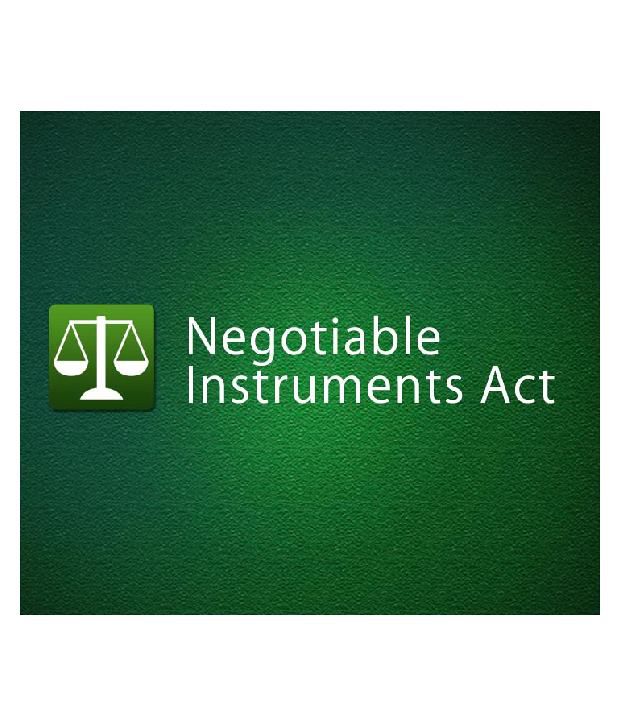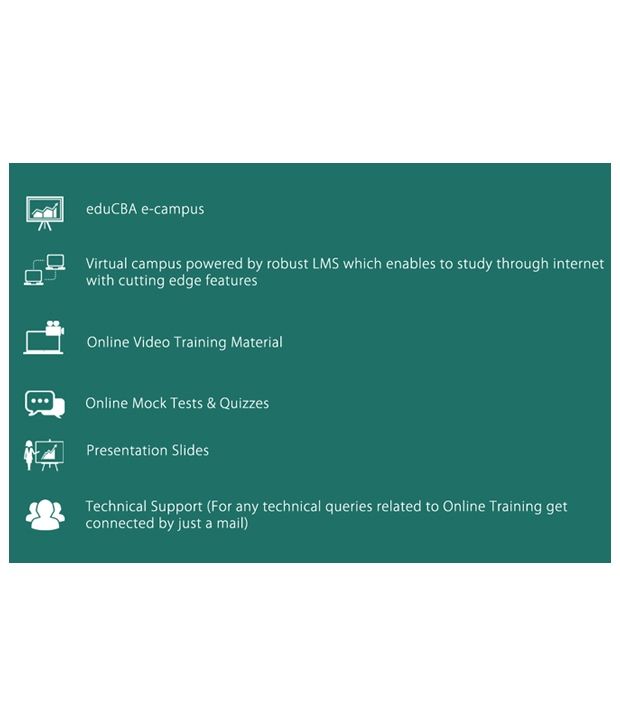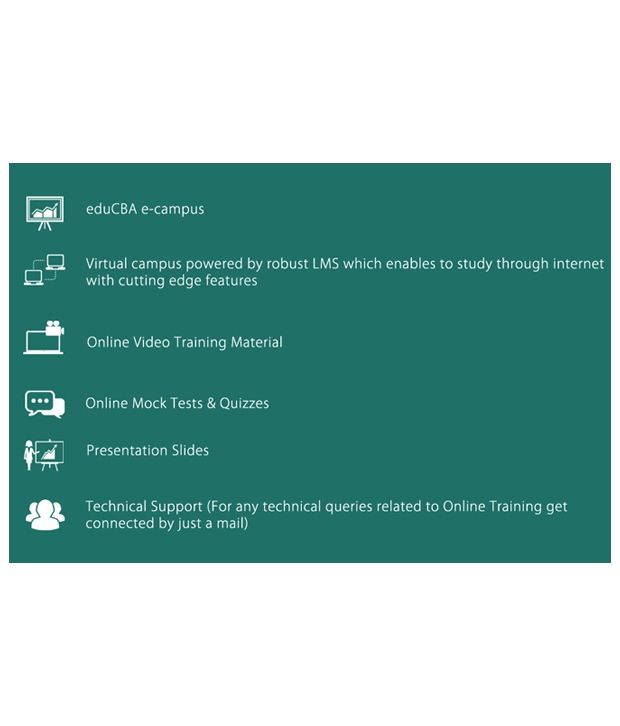Something went wrong. Please refresh the page and try again.
Something went wrong. Please refresh the page and try again.
Notifications can be turned off anytime from settings.
Item(s) Added To cart
Qty.
Something went wrong. Please refresh the page and try again.
Something went wrong. Please refresh the page and try again.
Exchange offer not applicable. New product price is lower than exchange product price
Please check the updated No Cost EMI details on the payment page
Exchange offer is not applicable with this product
Exchange Offer cannot be clubbed with Bajaj Finserv for this product
Product price & seller has been updated as per Bajaj Finserv EMI option
Please apply exchange offer again
Your item has been added to Shortlist.
View AllYour Item has been added to Shopping List
View AllSorry! Negotiable Instruments Act Certified Online Course by eduCBA - Online video training material, Verifiable Certificate, Technical Support is sold out.



You will be notified when this product will be in stock
| System (Hardware/Software) Requirements | |
| Operating Software | Windows XP or Higher |
| Processor | Minimum P4 or Higher |
| RAM | 1 GB or Higher |
| Browser | Any |
| Recommended Internet Speed | Minimum 1MBPS |
| Supported Browser Plug-ins | Updated Flash Player, Update Java |
| Other Requirements | Speaker or headphone |
Detailed Product Description:
The course on the "Negotiable Instruments Act" deals with complete details of enactment of the various acts with its amendments in conjunction with other laws under Indian Contract Act, Indian Stamps Act, Transfer of Property Act, Partnership Act, Indian Companies Act etc.
What are Negotiable Instruments, its definition under Section 13, and the essential features of a Negotiable Instrument are discussed with suitable examples, wherever necessary. How a Promissory note is defined under Section 4, a Bill of Exchange under Section 5 and a cheque under Section 6 are explained in a lucid manner for understanding the subject, for the beginners. Along with the technological developments in all other sectors, the banking sector also has undergone vast changes with the introduction of Core Banking Solutions and Internet based banking / Mobile banking services. The introduction of the computers and MICR cheques in 1980s were the early off-shooters in the banking sector, which have entirely changed the banking scenario in the country. The distinctions between a Promissory Note, Bill of Exchange and a Cheque are specifically narrated and discussed which will help the readers / listeners to fully understand them.
Classification of bills into Inland bills and Foreign bills, its individual features, dishonour of a bill, the rights available to the drawer and its endorsees on dishonour, the necessity for noting and protesting of a foreign bill, the process involved in the same, are explained in detail.
Who is a "Holder in due course" as defined under Section 9, what are the rights and privileges to him, are narrated clearly. The definition of "Payment in due course" under Section 10 and how it will protect a paying banker while making payment of an instrument are also discussed.
What is "negotiation" and what is the difference between "negotiation" and "assignment" are also discussed for a better understanding.
"Once a bearer, always a bearer" is the accepted norm under the banking circles which gives protection to a Collecting banker under Sections 131 and 85. Various other stipulations, such as the collecting banker should collect the instrument for his customer only, the instrument should be crossed and the banks should act in good faith and without negligence are the prime conditions to be met, for getting protection under Section 131, for a Collecting banker. This has been clearly explained here.
Definition of Endorsement, its different types and various provisions with regard to each, have been discussed in this lecture.
Different types of crossings such as general crossing, special crossing, Non-negotiable crossing, what are the implications of each crossing and the liability of the paying banker under Section 126, are briefed with illustrations. What does not constitute a crossing, like a "single line" or and mark "X" are also discussed for getting a clearer picture.
The responsibilities of a Paying banker and a Collecting banker are also explained in a nice manner.
Course Curriculum (Structure):
Section 1: Overview of Negotiable Instruments Act
1
Introduction to Negotiable Instruments
03:31
What are basically Negotiable Instruments, History of the Negotiable Instruments Act, 1881 and its various amendments , Meaning of the Negotiable instruments and how it is defined under the NI Act.
2
Features of Negotiable Instruments
07:28
Various featuers of the Negotiable Instruments, Its special features and distinctive features, its transferability by endorsement and delivery in case of order instruments and my delivery for bearer instruments. Two types of N.I. by statute and by custom. Which instruments do not come under N.I. The characteristics of a Negtiable Instruments and various presumptions on the same
3
Features of Promissory notes_Bill of Exchange and Cheque
06:13
Who are the parties to a Promissory Note, Bill of exchange and cheque. The essentials regarding the unconditional order in writing, signed by the maker, specifying the amount etc. Precautions while issuing the cheques, what are the MICR codes and how they identifies the bank and its branch.
4
Continuation of Promissory Note
06:38
This video tutorial is the continuation of Promissory Notes_Bills of Exchange
Section 2: Learning about Bills of Exchange, Pro note & Cheque
5
Distinction between Pro note and Bill of Exchange
02:32
What are the distinctions between a Pronote and Bill of Exchange as to the parties involved, Payment to the maker, Unconditional promise, Prior acceptance, primary liability, relation, protest for dishonour and notice of dishonour.
6
Classification of bills
06:40
What are Inland Bills and Foreign bills and how they are different from one another. The need of protesting in case of a foreign bill.Time bills are payable after a certain time while demand bills are payable at sight. Trade bill is a bill which is supported by a genuine trade transaction while accommodation bills are issued for accommodating the party by finace by bankers after discounting the the bills. There is no movement of goods in case of accommodation bills and no consideration is involved in the transaction. Drawees have to make the payment of the bill on due dates, whether it is a trade bill or accommodation bills. Foreign bills are prepared normally in two sets, where a minimum two original Bill of Lading are issued by shipping companies, one original attached to each set for the purpose of safety of the bills, due to any loss in transit.
7
Distinction between a Bill of Exchange and a cheque
06:31
A cheque is always drawn on a banker, while B/E can be drawn on a person or firm or even on a bank, if it is under L/C. Acceptance is necessary in case of B/E, while in case of a cheque it is not required. In a Bill of Exchange, grace period is allowed, while in a cheque it is not. Payment of a cheque issued can be countermanded, while the facility is not there in case of bills. Notice of dishonour is required in case of bills, while in case of cheque it is not required. Stamping is required in case of bills, while in case of cheque it is not required. A cheque can only be drawn on demand, while a B/E can be at sight or on usance. A cheque can be issued to a bearer, while a B/E cannot be issued to bearer.
8
Holder in due course
06:05
Definition of a holder in due course, rights of a holder in due course with regard to crossing, negotiability and for getting a duplicate one incase of loss of the original in transit. Various privileges regarding better title free from all defects ( section 53), every prior party to negotiate the documents (section 36), right in case of instrument received by unlawful means, estoppal against denying orginal validity, estoppel against denying capacity of payee to endorsee, estoppel against denying signature or capacity of prior party etc.
9
Payment in due course
06:22
Definition of payment in due course. Requirements of a paying banker to get protection while making payment under due course. Prudence of a banker while dealing with the negotiable instrument whether it is a cheque or bill. The need of taking ID proof of the person, if the bearer is a third party. In case of suspicion, a banker should contact the drawer and confirm the details of the bearer before making the payment, so as to get protection as well as to prove in a court of law at a later stage, if the payment is alleged to have made to a wrong person.
Section 3: Understanding about Negotiation & Endorsement
10
Negotiation and assignment
10:51
Definition of negotiation under Section 14, Two types of negotiation - by delivery ( Section 47 ) and and by endorsement and delivery ( Section 48). Negotiation requires delivery to constitute a transfer, while assignment requires a written document signed by the transferor. Consideration is presumed in negotiation, while considertion has to be proved in case of assignment. The requirement of notice of transfer in assignment is important. The right of transferee to sue a third party in his own name in case of negotiation is not available in case of assignment.
11
Endorsement
08:18
Who can endorse an instrument, different types of endorsements by the payee or the endorsee.Provisions regarding endorsement. Effects and right to endorsement. The necessity of the delivery of the instrument after endorsement so as to complete the process of negotiation. The use of allonge when space is not available in the instrument for endorsement. The r Endorsement in blank and general and in such case the bearer becomes the holder of the instrument.Endorsement in part is prohibited. Similarly there is no right for endorsement to the legal representative.
12
Continuation of Endorsement
07:18
General rules regarding the endorsement, such as signature of the endorser, the correct use of spelling, no addition or deletion of the initial in the names and ensuring not to use the prefix and suffix while endorsing the instrument to become effective and valid. The requirement of giving name and full address of the witness, when endorsement is done by an illiterate person.
13
Various types of endorsements
08:20
Endorsement in blank and full,Sans recourse, restrictive endorsements, conditional endorsements, partial endorsement etc. What are its efficacies in a court of law and for the purpose of negotiation.
Section 4: Types of Crossing of Cheques
14
Different types of Crossing of cheques
08:42
Position regarding stolen cheques, fruadulent instruments, forged endorsement, instruments received for no consideration- in all these cases the holder of the instruments do not get a better title than to its true owner.
15
Continuation of Different types of Crossing of cheques
07:24
What is crossing of cheques and what does not constitue crossing ? The two parallel transverse lines at the left hand corner of the cheque constitutes crossing. Two simple parallel lines with or without the words "and co" conforms to general crossing while " Non-Negotiable" or "XYZ bank" constitute special crossing.
16
Further continuation of Different types of Crossing of cheques
09:20
The only drawer and the collecting banker can cross the cheques. Various protection available to the paying banker when making payment of a bearer instrument irrespective of any crossing, the liability of the paying banker under Section 126 are aslo of prime importance.
17
Responsibilities of Paying banker
07:00
When will a paying banker get protection under Section 31 ? If he acts in good faith, without negligence and if he makes payments in due course. Collecting banker gets protection under Section 131, if he collects the crossed instrument for his account holder. The Payee can go to a court of law under Section 138, if the cheque is dishonoured for want of funds.
18
Collecting banker
06:49
There are certains also to be fulfilled such as issuance of due notice to drawer within the stipulated time of 30 days. The Punishment under the same extends to 2 years' imprisonment with fine.
Section 5: Bills for Dishonour
19
Noting of bills for dishonur
07:41
Dishonour can be two types- for non-acceptance and for non-payment. It is necessary to send a notice of dishonour to the drawee and other related parties when dishonour takes place, within a reasonable time by the easiest way of communication, depending upon the location of the drawer. Noting of the bill is required to be done for foreign bills.
20
Protesting of bills for dishonur
08:17
After noting of bills, protesting is also to be done. Noting and protesting is done by the Notary public at the place of the drawee, as per the law of the country concerned. Only after that, further action can be initiated against the drawee, like filing a recovery suit in a court of law.
21
Summary
02:25
Summary of what is discussed above.
Benefits:
Over 21 lectures and 2.5 hours of content!
Persons interested in the study of banking laws and practice - what are different laws enacted under the Negotiable Instruments Act, 1881 and its amendments thereof, over a period of time, in consonance with the technological changes in the banking field.
The legal department of banks and the general lawyers alike, can refer to these rules, at a glance in case of need, and can arrive at a decision, for future course of action, in case of disputes with the customer and a bank and vice versa
This course will also help the reader to appear for competitive examinations, internal written-test in banks. This will help anyone interested in this field, to have first-hand information on banking laws
How to use? (Steps to use Study Material):
Step 1 - eduCBA sends the redemption coupon along with the registration link.
Step 2 - Student will register with his register email id and coupon
Step 3 - Student receive the course access and password on his/her email id
Step 4 - Login using your email id and password and start learning
To get more information, you may want to watch the video below
FAQs:
Here you can have a look at our frequently asked questions. We have put together some simple answers you may have, Click here to take a look!
Learn Everything, Anywhere, Anytime
India's Largest Online Education Marketplace
The images represent actual product though color of the image and product may slightly differ.
Register now to get updates on promotions and
coupons. Or Download App